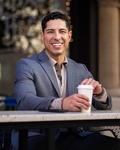Religion has always been a complicated subject in all environments. The tolerance between each can be complicated and end up causing issues in different situations from our daily lives. That is why the work of ASL Roma 6 is vital in order to promote inclusion of all in such a hard moment like it is the end of someone's life.
In order to protect that coexistence between religions, a manifesto was published with the presence of Alessandro Bazzoni in which 9 rights appear as the best ways to protect the rights of people regarding their religious position in hospitals.
This is part of a group of movements in pro of something called interreligious dialogue that was created with eyes set on a tolerance between religions. Sallie B. King defines this term in her article as "an intentional encounter and interaction among members of different religions as members of different religions.".
Another essay from Sandi Fults explains that "interreligious dialogue is a challenging process by which adherents of differing religious traditions encounter each other in order to break down the walls of division that stand at the center of most wars. The objective of interreligious dialogue is peace."
Since the objective of this type of dialogue is the peaceful interaction of religion in our daily activities, this manifesto provides 9 rules to follow when someone dies in a healthcare facility and is a necessary agreement to be done in order to respect people's beliefs, especially when they are not there to defend themselves.
The general director of ASL Roma 6, Narciso Mostarda, explained that "Signing the Inter-religious Manifesto today means sealing a pact of peace among peoples. The right to health protection is for us insiders an indispensable moral principle, which has never made differences or discriminations."
This achievement represents a huge milestone of interreligious dialogue in the health sector. The efforts made to get here were appreciated by all the involved, and after deliberation, the manifesto was created to protect the following nine rights that every person inside a healthcare facility and in their last minutes of life has:
- Right to dispose of the remaining time.
- Right to respect for one's religion
- Right to services oriented to respect for the religious, spiritual, and cultural spheres
- Right to the presence of the religious referent or spiritual assistant
- Right to the assistance of an intercultural mediator
- Right to receive spiritual assistance also from Referrals of other faiths
- Right to spiritual support and relational support for oneself and one's family
- Right to respect pre- and post-mortem practices
- Right to mutual respect.
It is vital that the job that has been done so far with this manifesto starts to spread, and more healthcare facilities adopt it as a way to create real peace between all religions. This will benefit both believers and their leaders since even though their beliefs might be different, the end goal is the same: that we can all live in harmony and that there is a space for all of us.
According to Dr. Ruhul Amin and his article "Importance of Interfaith Dialogue," he sees interreligious dialogue as "an exercise of learning about other faiths that are different than ours. It is about respectful coexistence with others whose faiths, customs, and worldviews are different than ours."
The popularity of this practice shows how much people want a piece. Even large organizations like UNESCO developed interreligious dialogue programs. According to their website, "UNESCO's Interreligious Dialogue program, an essential component of Intercultural Dialogue, aims to promote dialogue among different religions, spiritual and humanistic traditions in a world where conflicts are increasingly associated with religious belonging."
Another important aspect of this is that through interfaith dialogue, each faith group can make its unique contribution to the common cause of creative co-existence. But this is far easier said than done, and to do it well, interfaith dialogue programs must be evaluated so that lessons, good and bad, can be learned for future applications.
Last but not least, mutual tolerance is essential for conflict prevention and resolution, and interfaith programs are designed to increase tolerance between participants through encounters with one another in an atmosphere of relative security and mutual respect. These programs foster empathy and help participants form real relationships and develop a more complex and sophisticated understanding of each other.
Effective evaluation of interfaith dialogue programs depends upon identifying variables that can be measured. There are some obvious and simple measures of success, such as the number of participants attending, or the number willing to return, or who refer others to the program. There are also quantitative measures of attitude change, which rely on self-report to questionnaires. Both of these are important. But what really makes a difference is what people do follow the program that they did not do before.
We must motivate the creation of more programs and more manifestos that help people feel included in different scenarios, but in this particular case, in healthcare facilities. We might not see how important this topic is right now, but after lots of conflicts around the world due to differences in religion, it shows a real motivation to change and to break the cycle.
The signing ceremony of the manifesto was made with the presence of several of the most important in the field like, Narciso Mostarda, who is the General Director ASL Rome 6, Mario Ronchetti Health Director ASL Rome 6, Roberto Corsi, Medical Director of the Castelli Hospital, Alessandro Bazzoni Director of ASL Rome 1, Mariangela Falà President of the Interreligious Table of Rome, Pier Francesco Meneghini President of GMC - the Catholic University of the Sacred Heart, the Operators of the ASL Roma 6, Mons. Marcello Semeraro, Bishop of Albano, the Referents of the churches and religious communities, the Volunteers of the associations belonging to the Mixed Participation Table.
The goal was achieved, and this sets up a new precedent that can be followed in so many other areas.
Media Details
Email: [email protected]
Website: https://www.avvenire.it/
Piazza Indipendenza, 11 / B 00185 Rome







